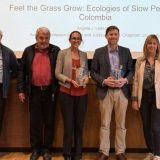Understanding Discoveries at Cástulo better …
September 5, 2014
In my last blog post (for the time being), I wanted to discuss some of the extraordinary work being done by my Spanish colleagues at Cástulo. For the most part, these new developments apply to the visualization of objects and of the site itself. These visualizations can help other archaeologists to understand the discoveries made at Cástulo better — but they also are being used to engage the general public with the ancient past. I’ll describe three of these developments here.
Database
Probably the most important innovation introduced by FORVM MMX pertains to the collection of data. The project developed a new kind of archaeological database that holds information about all of the trenches and objects found on the site. Trench supervisors fill out special forms with a pen that doubles as a mini-scanner. The pen records all of the data as it is written and sends it via Bluetooth to a Blackberry smartphone, which then sends it along to the database server back in the museum in Linares. In other words, whatever is found on site is instantly recorded to the database — and the written form serves as a hard-copy back-up! FORVM MMX archaeologists can look up information on any object, trench, or stratigraphic level immediately, and connect it to other information from the same area or period. A geographic information system (GIS) in the database also allows finds and strata to be plotted on a map of the site.
- Ima fills out a form using the BlackPen/BlackBerry combo.
- View of the FORVM MMX database screen showing individual objects recorded from one part of the site.
- The database identifies a specific stratigraphic unit in a trench and displays it in three dimensions over a satellite image of the site
Photogrammetry
In the past few years, as technology prices (especially software) have decreased, archaeologists have started to take advantage of a new form of documentation called photogrammetry. This technique uses photographs of an object or location taken by an ordinary digital camera from many different angles to create a three-dimensional model of the object/location. In January of this year, I participated in an effort led by the French School of the Far East to document sculptures looted in the 1970’s from a 10th century CE shrine. I took dozens of photos of a sculpture in the Norton Simon Museum, which were then used to create a 3D model of the artwork that could be placed in a recreation of the shrine. (Photo Copyrights: École Francaise d’Extrême-Orient)
- One of my photos of the Bhima sculpture from Koh Ker, Cambodia.
- The photogrammetric reconstruction of the Bhima scultpure made from my photos.
- Photogrammetric reconstruction of the trenches excavated to reveal Building E — an early Christian building — at Cástulo.
The FORVM MMX team has adopted photogrammetry as a way of documenting the development of trenches as they are excavated. Every time the archaeologist supervising a trench decides that a new layer of soil or built structure has been revealed, the trench is cleaned and the site photographer takes multiple pictures of the trench from every direction. Later, back at the museum, the photographs are stitched together to produce a 3D model that can be manipulated and enlarged. Photogrammetry is not just a better way to communicate and document the process of excavation; it also saves a lot of time, because it allows archaeologists to avoid the time-consuming process of drawing the trench and the profile of stratigraphic layers in the trench walls.
3D models of artifacts
A similar development has occurred with regard to individual objects recovered through excavation. Although high-quality 3D scanners are still prohibitively expensive, it is possible to use photogrammetry to create models of artifacts. These models can be distributed on the web, even through Facebook, so that members of the public can have the chance to “hold” an ancient object and turn it around to see all of its sides. The models can even be annotated, allowing users to click for more information about particular features of the object (at the moment these are only in Spanish, but we plan to add English text in the near future). Some examples created by the FORVM MMX team include a quartz pendant from a necklace, an iron key, a terracotta figurine of a seated woman, and a bone tool.
With these new technological tools, it has become possible to bring ancient artifacts to the global public in ways that were never possible before, to conduct faster professional excavations, and to document excavations in ways that allow for easier understanding of the data. FORVM MMX is leading the way in all of these areas.
If you have questions or comments about any of these blog posts, please contact Professor Walsh.
Ancient Castulo Part One | Ancient Cástulo Part Two | Ancient Cástulo Part Three | Ancient Cástulo Part Four








